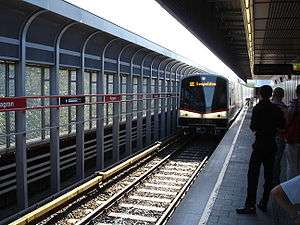U1 (Vienna U-Bahn)
Line U1 is a line on the Vienna U-Bahn metro system.[1] It currently has 24 stations and it runs 19.2 km from Oberlaa to Leopoldau. When the extension to Oberlaa was completed in 2017, the line became the longest on the network, surpassing the length of Line U6. It is connected to Line U2 and Line U4 at Karlsplatz, Line U3 at Stephansplatz, Line U4 at Schwedenplatz and Line U2 at Praterstern. The line opened on 25 February 1978.
 Line U1 train at Kagran | |
| Overview | |
| Type | Rapid transit |
| System | Vienna U-Bahn |
| Status | Operational |
| Termini | Oberlaa Leopoldau |
| Stations | 24 |
| Operation | |
| Opened | 1978 |
| Operator(s) | Wiener Linien |
| Depot(s) | Kagran (closed 2006), Leopoldau, Neulaa |
| Technical | |
| Line length | 19.2 km (11.9 mi) |
| Track gauge | 1,435 mm (4 ft 8 1⁄2 in) |
Stations
History
The Construction of U1 (1969-1982)
The modern construction of Vienna's railway was built on the 3 November 1969.[2] This consisted of the newly built U1 line, and two merged lines from a tram and old metro, of the line U2 and U4 respectively. As the result of a more streamlined network, there were new routes between U1, U2 and U4.[3]
Line U1 Routes: Reumannplatz - Stephansplatz - Praterstern (6.1 kilometres in length)[4]
The construction started in Karlsplatz, the largest interchange station in Vienna. On 25 February 1978, the first Vienna U-Bahn route between Karlsplatz and Reumannplatz, the U1, went into operation. All sections of the basic network were in operation by December 1981. The extension of line U1 to Kagran (3.9 km), which was not part of the original plans and was added later when the Reichsbrücke over the Danube collapsed in 1976, was completed in September 1982.[5] Finally, the Vienna U-Bahn basic network was completed on 3 September 1982, where the network reached a total length of 30 kilometres.[6]
The development of the cars of both the U1 and U2 Trains was by Simmering-Graz-Pauker (SGP) in 1972.[7] This unit had a two-axle motorcar, it was 36.8 metres long and 2.8 metres wide and a permanently coupled twin railcar. A train was made up of three double cars. From 1987, SGP upgraded their cars' technical equipment, which included water-cooled three-phase motors, brakes with energy recovery and modernised emergency braking and safety equipment.[8] In 2006, the U1 and U2 LED displays replaced the original in-and-out illuminated telltale displays. In addition, the trains were retrofitted with plastic seats, video surveillance and warning lights that had signalled the door closing. An individual car consists of 49 seats and 91 standing spots.
References
- http://homepage.univie.ac.at/horst.prillinger/metro/english/u1.html
- Rout, Stephen. "Vienna Underground Train System - Information from Vienna Direct". ViennaDirect. Retrieved 2018-09-14.
- Prillinger, Horst. "The Modern Metro (U-Bahn), Phase 1 - The Vienna Metro". The Vienna Metro. Retrieved 2018-09-14.
- "U1 Route: TIme Schedules, Stops & Maps". Moovit. Retrieved 2018-09-14.
- "Wiener U-Bahn-Bau". ORF.at. Retrieved 2018-09-14.
- "U-Bahn Line U1". WienVienna. Retrieved 2018-09-14.
- Horst, Prillinger. "U, U11 and U2 Stock". The Vienna Metro. Retrieved 2018-09-14.
- "Vienna U-Bahn". Rehau. Retrieved 2018-09-14.
External links
